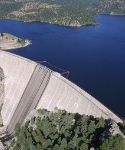| Meeting the water crisis: Gross Reservoir |
 |
| Written by Matt Wittern, Denver Water |
| Tuesday, July 09, 2019 03:00 AM |
|
The ebb and flow of water Overall, the 2018 water year was the 10th driest for stream flows across Denver Water’s 4,000-square-mile collection system. The amount of water in the streams flowing past measurement gauges was 63 percent of normal during 2018. The driest year in Denver Water’s history books was 2002, when stream flows were only 31 percent of normal. Last year’s snowpack was lopsided; more snow fell on the northern parts of the state, while drought conditions that started in February in the southwest corner of Colorado expanded north and east last fall. All of this is cause for concern, and one of the reasons Denver Water is proceeding with plans to expand Gross Reservoir in Boulder County, which stores water collected from watersheds on the West Slope in Grand County. When the Gross Reservoir Expansion Project — which is in the final stages of approval after nearly 15 years of permitting — is complete, Denver Water will have more flexibility throughout its system to react to year-to-year changes in snowpack levels, extreme weather swings and natural and human-caused disasters. The expansion is a major component of Denver Water’s long-term, multi-pronged approach of promoting water efficiency, developing recycled water and responsibly sourcing new supply in order to deliver safe, reliable water. The additional water storage will help prevent future shortfalls during droughts and help offset an imbalance between Denver Water’s North and South water collection systems, which creates a vulnerability that concerns water planners. New era of cooperation These traditional foes have agreed to settle water disputes not in court, but at a conference table. Going forward, they will work collaboratively instead of competitively. Environmental benefits The expansion will enable Denver Water to help stressed streams during hotter and drier times in Grand County. “Denver Water has worked to ensure that there are temperature safeguards built into the agreement,” said Jon Goldin-Dubois, president of Western Resource Advocates. “So, if the temperature rises in Western Slope waters, Denver Water can release additional water. The project ensures better river health on the Western Slope.” Stream health improvements also extend to the East Slope because Denver Water, in partnership with the cities of Boulder and Lafayette, will include space for a 5,000-acre-foot environmental pool in the enlarged reservoir. Strategic water releases during the typically dry winter months into South Boulder Creek will help those cities improve stream health in a 17-mile stretch of South Boulder Creek below Gross Dam. “Bottom line, these environmental commitments are significant points of pride for us,” said Denver Water CEO/ Manager Jim Lochhead. “They — along with the relationships we’ve built during the nearly 15 years of this project’s development — are part of Denver Water’s commitment to be a responsible community partner and to do the right thing. We’re proud that this project will help us achieve our goals of providing a secure water supply for our customers while providing net environmental benefit to state water quality.” Matt Wittern is community relations liaison at Denver Water. This story originally appeared in the January-February 20196 issue of Colorado Green magazine. Read more in this issue of Colorado Green NOW: |

 More than 1.4 million residents today depend on Denver Water to deliver safe and reliable water, as will many of the projected 7.7 million who will call Colorado home by 2040. The Gross Reservoir project, expected to be complete in 2025, will raise the height of the existing dam by 131 feet, which will allow the capacity of the reservoir to nearly triple and store 119,000-acre feet of water.
More than 1.4 million residents today depend on Denver Water to deliver safe and reliable water, as will many of the projected 7.7 million who will call Colorado home by 2040. The Gross Reservoir project, expected to be complete in 2025, will raise the height of the existing dam by 131 feet, which will allow the capacity of the reservoir to nearly triple and store 119,000-acre feet of water.